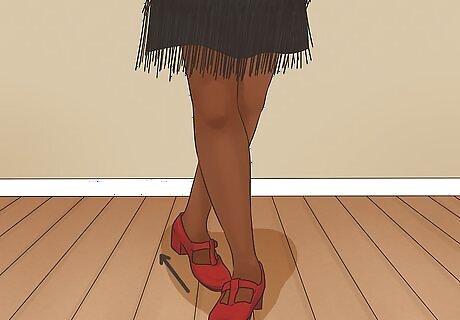
views
Mastering the Basic Move

Take a rock step back with your left foot. Touching the front of your foot to the floor, but not bringing your heel down. Don’t fully shift your weight to this foot. When doing the Charleston, lean forward slightly and bend your knees a little. Keep your weight on the balls of your feet. A rock step, also called a break step, refers to a rocking step in which one’s weight is very briefly transferred to another foot before being returned to the first. The only time when you might begin with your right foot is if you are following a partner. When two people dance the Charleston together, the leader starts by stepping back on the left foot, while the follower starts by stepping back on the right, mirroring the leader.

Step back forward with your left foot. It should now be a step ahead of your right foot. This time, shift your weight to your left foot.

Take another rock step forward with your right foot. Put the heel of your foot on the ground without bringing your whole foot down. Your weight should end up on your left foot still.

Step back with your right foot. It should now be a step behind your left foot. Shift your weight back onto your right foot.

Swing your arms as you step. As you move, your arms should be swinging. This may happen automatically, especially if you’ve seen people do the Charleston before and know what it’s supposed to look like. When your left foot is in front of you, your right arm should swing forward. When your right foot is in front of you, your left arm should swing forward.

Repeat this movement. It probably won’t look terribly impressive on its own, but the back, forward, forward, back motion is the building block for every variation on the Charleston. Practice until it feels natural. Then you’ll be ready to start mixing things up.
Doing the 20s Charleston

Get comfortable with the basic move. All the variations of the Charleston start with being able to do the basic step. Practice until it becomes second nature.

Twist your feet in and out. Keep your weigh on the balls of your feet. On every step, the heel of the foot your have your weight on should twist out and then in again.

Lift your elbows as you swing your arms. This is basically an exaggerated version of the arm swing. As always, your left arm should swing forward when your right foot is ahead of your body, and your right arm should swing forward when your left foot is in front of your body. Your arms should be bent at about a 90 degree angle. The elbow of the arm that is swinging back should come to shoulder height, and the forearm of the arm that is swinging forward should be parallel to the ground.

Pivot your knees in and out. One common move used with the Charleston involves opening and closing your knees at the same time as crossing and uncrossing your arms. This may be the most well-known Charleston move. Begin with your knees bent and touching each other, with your arms crossed over them, so that your right hand is on your left knee, and your left hand is on your right now. Spread your knees apart while simultaneously uncrossing your arms, so that you end up with your left hand on your left knee, and your right hand on your right knee. #*Repeat this move a few times.
Doing the 30s Charleston

Get comfortable with the basic move. All the variations of the Charleston start with being able to do the basic step. Practice until it becomes second nature.

Replace a normal step with a kick step. This will add a little pep to the move. Instead of simply stepping forward, bring your knee up and kick your foot out. Your knee should come up first, propelling your foot forward a moment later. If you would not be transferring your weight to that foot anyway for this step, just swing it back again without letting it touch the ground. Otherwise, plant it back on the ground after the kick.

Add a hitch as you move your leg back. Instead of simply stepping back after a kick, incorporate a hitch into the movement. Bring your knee back up, so that your upper leg is parallel to the ground, before kicking your foot back again.

Touch the ground with your hand. This adds slightly more difficulty and flare. As your leg swings back and the ball of your foot touches the ground, lean forward and tap the ground with the tips of the fingers of your opposite hand.




















Comments
0 comment